This morning I looked out of the window in my dorm and it looked clear. However, when I walked out I could barely see the building that houses the galley. It wasn't snowing that much but the wind was blowing hard and the snow was everywhere. I looked over and saw this little vehicle. It looked so out of place among the other mammoth ones. I have had a little trouble getting in and out of the various vehicles because they are all so high. The tires are super duper big and they lift the vehicles high above the road. This little vehicle almost looked like a toy and the snow seemed to have started to swallow it. I wanted to pick it up and take it with me so that I would have a vehicle that was my size.
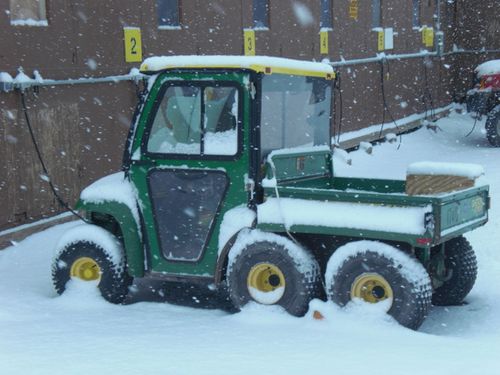 This is the first vehicle I have seen that I could get into without a step stool.
This is the first vehicle I have seen that I could get into without a step stool.
As I entered the dining hall I looked up and noticed that the message board stated that it was Condition Two. I wondered just how bad it would be if it was Condition Three. The winds are sudden and ferocious. I have now had a taste of just how harsh Antarctica can be.
 This is one of the signs that lets everyone know that it is Condition Two. During this stage you cannot use snowmobiles or skis and the helicopters usually do not operate.
This is one of the signs that lets everyone know that it is Condition Two. During this stage you cannot use snowmobiles or skis and the helicopters usually do not operate.
The helicopter flights were cancelled again due to the strong winds. The team decided to try and do a technical or tech dive with SCINI 2 because SCINI 1 is on Heald Island. This required a lot of prep work. I used an electric knife to trim the foam inside the second carrying box for SCINI while the other team members made additional preparations. The boys (Bob, Francois, and Scott) took SCINI 2 and headed for the Jetty, which is less than a mile from the lab, to perform the tech dive. Stacy and I stayed in the lab and did work on the computer. I am sadly still behind and trying desperately to get caught up. There just don't seem to be enough hours in the day for everything that needs to be done.
I thought today would be a good time to tell you a little about the geography of Antarctica. It is really is an amazing continent. As you know, it is the highest, driest, coldest, windiest, and harshest continent on the planet.
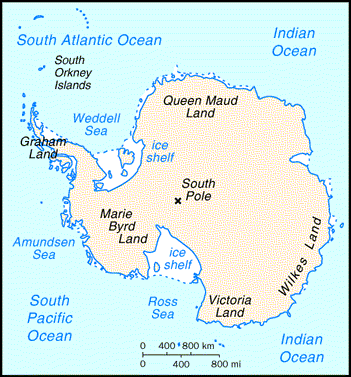 This map shows the basic regions in Antarctica.
This map shows the basic regions in Antarctica.
Antarctica is the fifth largest continent and encompasses approximately 5 million square miles of land. About 98% of the land is covered with ice and the remaining 2% is essentially barren rock. Most of the areas that are free of ice are along the coast and include parts of Ross Island on McMurdo Sound, the McMurdo Dry Valleys in Victoria Land, Wilkes Land, and the Antarctica Peninsula area. There are ice shelves along about half of the coast line that were formed by glaciers and the Ross Island Ice Shelf is the largest covering about 200,000 square miles. If the ice were to melt there are some that estimate that the water level around the world would increase by 200 feet. The ice will sometimes break off in the ocean forming ice floes. The ice is formed from compacted snow and is composed of fresh water. All of this ice in Antarctica accounts for 90% of the ice and 70% of the fresh water on Earth.
Antarctica also has the Tranantarctic Mountains. The largest is Vinson Massif which is 16,000 feet above sea level. The average height of the mountains on Antarctica is higher than any other continent which is why it is said to be the highest continent.
Antarctica is also the world's largest desert. I know that it is hard to believe that a continent covered in ice is a desert, but it is. It averages only 2 inches of precipitation each year because the air is too cold to hold moisture. This is why it is known as the driest continent.
You can also find several volcanoes on Antarctica. Mount Erebus is the most well-known and it is still active. I also think it is quite beautiful.
Antarctica is also known as the coldest continent on the planet. This is a well-deserved description. Temperatures have been recorded to be as low as 128 degrees below zero (Fahrenheit). The average temperature near the South Pole is 71 degrees below zero (Fahrenheit) and the coast is a little warmer. There have been recordings of temperature as high as 59 degrees above zero (Fahrenheit) along the Antarctic Peninsula. These extreme temperatures are a big reason that humans have a difficult time surviving here.
The wind also has a huge effect on the temperature. Katabatic winds, which are driven by gravity, will blow towards the coast and cause the temperature to drop substantially. Winds have been known to get as strong as 200 miles per hour. Antarctica is undoubtedly the windiest place in the world.
Is it any wonder that Antarctica is considered the harshest continent on Earth? Some of the natural disasters that you could encounter include blizzards, cyclonic storms, and possible seismic activities. You also have to deal with the extreme cold, strong winds, and almost total lack of vegetation. This is not a place for the faint of heart.
However, the continent is not devoid of life. There are many beautiful animals that make Antarctica their home. All of the animals live at least part of the time in the water, with the exception of the mite. This is an almost microscopic organism that many people are allergic to.
Among the more visible animals are the seals. There are four types of seals present on Antarctica and they are the Weddell seals, the Ross seals, the leopard seals, and the crabeater seals. The most abundant variety is the crabeater seals which number close to 20 million.
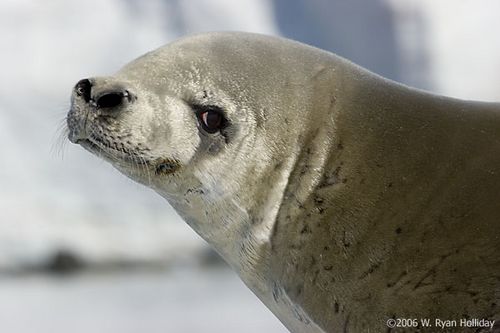 Their primarily source of food is krill not crabs.
Their primarily source of food is krill not crabs.
The other type of mammal that you will find in Antarctica is a whale. You may see sperm whales, blue whales, minke whales, or even killer whales.
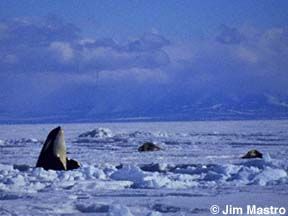 This animal has many names including Orca, Blackfish, Grampus, and the Sword Fish.
This animal has many names including Orca, Blackfish, Grampus, and the Sword Fish.
Another very popular animal in Antarctica is the penguin. Almost 80% of all birds in Antarctica are penguins. The varieties include Adelie, African, Chinstrap, Emperor, Erect-crested, Fairy, Fjordland-Crested, Galapagos, Gentoo, Humboldt, King, Macaroni, Magellanic, Rockhopper, Royal, Snares Island, and Yellow-eyed. They are extremely adorable.
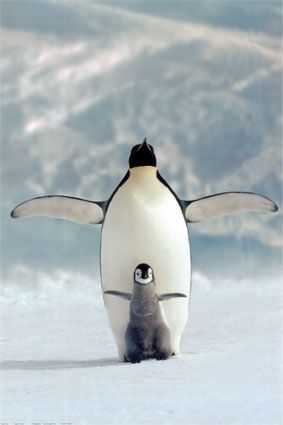 This is the largest variety of penguin and they are the only penguins to breed during the Antarctic winter.
This is the largest variety of penguin and they are the only penguins to breed during the Antarctic winter.
Other types of birds seen in Antarctica include skuas, albatrosses, and the Arctic tern which flies between the North and South Polar regions (it is also the mascot for the PolarTREC program).
In addition, there are many types of fish, as well as octopus and squid. You also will find a huge variety of marine life including starfish, jellies, and anemones.
It is hard to believe that over 200 million years ago Antarctica was full of plants and animals. There was no ice and life was everywhere. At one point Antarctica, South America, Africa, India, and Australia were all connected into one large land mass known as Gondwanaland. Events occurred and the land mass split to form what we have today. It makes you wonder what the Earth will look like in 200 million years from now. I wish I could be here to see it.
The information that I presented today was collected from a variety of sources. They were Wikipedia, C.I.A. - The World Factbook, WorldAtlas.com, University of Texas - Department of Education, Online Learning Haven, and the U.S. National Science Foundation's pamphlet "Facts about the U.S. Antarctic Program." The pictures of the animals were obtained from the internet and maybe one day I will see these beautiful creatures myself. I hope that you will take the time to further research this truly amazing place or better yet, start trying to find a way to visit it yourself.

